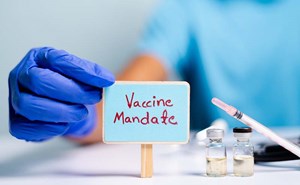On Monday, I had the opportunity to participate in a webinar sponsored by the Geriatric Emergency Department Collaborative on emergency department (ED)-based telehealth models. I spoke about the temporary regulatory changes that the Centers for Medicare & Medicaid Services (CMS) has made to Medicare telehealth policies in response to the COVID-19 pandemic (if you need a refresher on these changes, please click here).
During the webinar, someone asked the intriguing question of whether I thought any of CMS’s recent telehealth flexibilities could become permanent. In answering that question, I started with a quote from CMS Administrator Seema Verma, who said, "I think the genie's out of the bottle on this one. I think it's fair to say that the advent of telehealth has been just completely accelerated, that it’s taken this crisis to push us to a new frontier, but there's absolutely no going back." I agree with Administrator Verma that we are now seeing an expansion of telehealth that we have never seen before, and it is hard to imagine ever going back to where we were before. However, for us to keep up the momentum and not return to the pre-pandemic telehealth world, a few things need to happen:
- The ED evaluation and management (E/M) codes need to be permanently added to the list of approved Medicare telehealth services. CMS has temporarily allowed you to bill the codes you are most familiar with—the ED E/M codes, observation codes, and critical care codes—when performing emergency telehealth services from any location. We have argued that these codes appropriately reflect the value and intensity of emergency services and should be used regardless of whether care is delivered in-person or via telehealth. CMS has agreed with us—for now—but it needs to take the extra step of permanently adding these codes to the list of approved Medicare telehealth services. ACEP has formally asked CMS to do so, and we should know whether CMS will approve our request in June or July when the Medicare physician fee schedule proposed reg is released.
- State Medicaid programs and commercial payors need to follow Medicare’s lead. I’ve heard from some of you that it’s still challenging to set up emergency telehealth programs because payors and state have different billing policies that may not align with Medicare’s. For example, many commercial payors are not allowing you to use the ED E/M codes for emergency telehealth services. If you aren’t getting properly reimbursed by all payors, it can be exceedingly difficult for your telehealth programs to be sustainable. Furthermore, states have different regulations around licensing and telehealth that you have to comply with, which may restrict your ability to provide telehealth services to all your patients. In all, we need state regulations and Medicaid and commercial payor’s billing policies to follow Medicare’s lead and embrace the telehealth expansion. While some states and commercial payors are in fact implementing flexible telehealth policies that are similar to Medicare’s, they all need to get on board.
- Congress needs to change the Medicare telehealth statute: CMS has the authority during the pandemic to waive parts of the Medicare statute that may impede the ability for health care providers to care for patients. The agency is using that waiver authority to implement many of the Medicare telehealth flexibilities, such as allowing you to provide telehealth services from any physical location in both urban and rural areas. Once the pandemic ends, CMS will lose its ability to waive these restrictions. Congress must therefore act and make permanent changes to the Medicare statute. Specifically, Congress should permanently repeal the “originating site” requirement, which forces patients to travel to certain health care facilities to receive telehealth services (they cannot receive them from their home), and the geographic restrictions, which only allow Medicare telehealth services to be reimbursed when they are performed in rural areas.
While it is up to federal decision makers to act, you all have an important responsibility. Now is the time for you, as emergency physicians, to demonstrate the value of emergency telehealth services. If we can get Congress and the administration to realize that providing emergency services remotely is safe and effective and benefits patients, the temporary flexibilities have a better chance of becoming permanent.
Since there is so much regulatory activity going on beyond the exciting changes to telehealth, I want to also provide some other important regulatory updates from the week:
- The Department of Health and Human Services (HHS) issued additional frequently asked questions (FAQs) on the Provider Relief Fund, including clarifying the balance billing prohibition in the terms and conditions. As I noted in a previous post, we have multiple questions and concerns about the balance billing prohibition that is tied to the provider relief funds. In the updated FAQs, HHS provides additional clarification, but more is needed. First, the prohibition on balance billing applies to “all care for a presumptive or actual case of COVID-19.” HHS now defines a “presumptive case of COVID-19” as a case where a patient’s medical record documentation supports a diagnosis of COVID-19, even if the patient does not have a positive test result in his or her medical record. HHS also now states there are no limitations on the ability of a provider to submit a claim for payment to the patient’s insurance company and that “most health insurers have publicly stated their commitment to reimbursing out-of-network providers that treat health plan members for COVID-19-related care at the insurer’s prevailing in-network rate.”
- As discussed in a previous post, under the new uninsured reimbursement program, you can get reimbursed for certain “testing-related” visits, including ED visits, as long as the claim includes one of three diagnosis codes: Z03.818, Z11.59, or Z20.828. HHS recently released a new set of FAQs that clarifies that these diagnosis codes can appear in any position on the claim. This subtle clarification is extremely helpful, as previously it was unclear whether the diagnosis codes for testing-related visits had to appear as the primary diagnosis on the claim—as they do in most cases for COVID-19 treatment services (diagnosis codes B97.29 and U07.1). Now you have the flexibility to submit a testing-related visit claim for reimbursement that includes another diagnosis code as the primary diagnosis instead of one of the three required codes.
- The Families First Coronavirus Response Act waives patient cost-sharing for COVID-19 related tests and testing-related services. CMS issued guidance a while ago stating exactly when cost-sharing should be waived for Medicare beneficiaries. However, it was unclear from the guidance whether the waiver would apply if health care providers evaluate a Medicare beneficiary with flu-like symptoms but wind up not ordering or administering a COVID-19 test. CMS recently clarified that health care providers must order or administer a COVID-19 test for the cost-sharing waiver to apply.
- On Monday, CMS issued its annual Medicare inpatient hospital proposed reg. Of note, CMS is doubling down on its prior hospital price transparency policy (which is currently tied up in litigation) by proposing to require hospitals to report their median negotiated inpatient services charges for Medicare Advantage organizations and commercial payors. CMS is seeking comment on potentially using this information to set hospitals’ Medicare payment rates in the future.
CMS is also proposing policy changes to how residency slots are calculated when hospitals close (this is primarily in response to the closure of Hahnemann University Hospital). Specifically, CMS is proposing to expand the definition of a displaced resident to include those who may not be physically present at the hospital when it closes. According to CMS, this change would provide “greater flexibility for the residents to transfer while the hospital operations or residency programs were winding down.”
That’s a wrap for this week. Please continue updating me on any issues you are experiencing with trying to receive funding from the Provider Relief Fund—and let me know if you have any questions or concerns about the numerous reg changes CMS and other federal agencies are making!
Until next week, this is Jeffrey saying, enjoy reading regs with your eggs!






